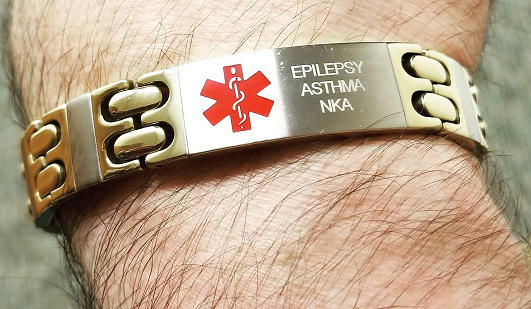

Medical IDs for Epilepsy
Epilepsy is a serious neurological disorder that affect 1.2% of the total US populations. According to CDC, there are about 3.4 million people with epilepsy nationwide. 3 million of these are adults and 470,000 are children. It is important to know that anyone can develop epilepsy regardless of gender, ethnic background, or age.
“Persons with epilepsy should wear medical alert jewellery (for example, a medical ID bracelet) so that prompt medical treatment can be obtained if a seizure occurs.” – Houston Methodist
Epilepsy and Seizures
The main symptom of epilepsy is repeated seizures that are caused by abnormal brain activity. Seizures can happen any time and cause a person to experience the following:
- loss of consciousness
- fainting or falling down
- body stiffening, jerking, and shaking
- loss of muscle control
- confusion
There is no need to call an ambulance if a person is known to have epilepsy and the seizure ends in under five minutes. An ambulance should only be called if the person is pregnant, injured, or diabetic, the seizure continues for more than five minutes, a second seizure happens right after the first ended, and consciousness does not return even after shaking has stopped.
Communicating Epilepsy in an Emergency
Seizures do not usually require emergency medical attention especially if a person is diagnosed with epilepsy. Wearing a medical ID is a simple and effective way to communicate epilepsy, even when the person becomes unconscious or unable to speak. Having a medical alert bracelet or necklace can help avoid unnecessary emergency room visits after a seizure has occurred.
Not wearing a medical ID prevents others from knowing whether the seizure is caused by epilepsy or if a person has other medical conditions. This is important for people to know whether they should call an ambulance or not, especially if a seizure only lasts under five minutes.
“Because a seizure can strike at any time, do your best to be prepared. If you have uncontrolled seizures, don’t drive to reduce your risk of being in an accident. Ask your doctor about wearing a medical alert bracelet that identifies you as having epilepsy so that people will know what to do if you have a seizure. “ – Columbia University Department of Neurology
What to Engrave on an Epilepsy Medical ID
Epilepsy is a serious medical condition that emergency and health professionals should be alerted of. Every person's medical conditions are different hence, it is recommended to choose a personalized medical alert jewellery that can hold unique and specific medical information about their epilepsy. This can include the following:


Photo credit: Epilepsy Empowered
- Your Full Name to identify yourself and give responders a way to address you
- Your Epilepsy and if you have other medical conditions such as Diabetes or allergies to certain food or medication
- Epilepsy Medications such as anticonvulsant/anti-seizure if you are taking them
- In Case of Emergency Contact


“I would love to see people with epilepsy living their lives, not feeling held back by their condition. But that means we’re likely to be around people who don’t know we have epilepsy, and don’t know what to do if we have a seizure. Wearing a medical ID can help us deal with that by letting people know about our conditions. The ID can speak for us when we can’t. Getting one gives you peace of mind, and helps those around you help when you need it. If you have seizures fairly often, and put yourself out there among people who don’t know about your epilepsy, you should strongly consider getting one. – Matt Gutting, Epilepsy Empowered

 - US
- US  - Canada
- Canada  - Australia
- Australia 